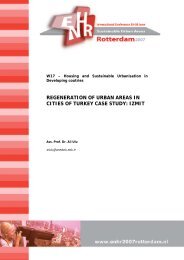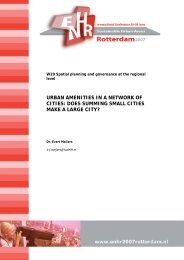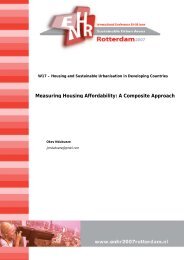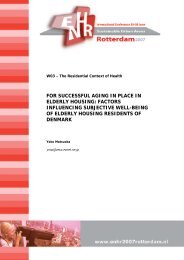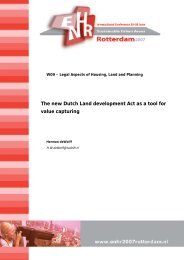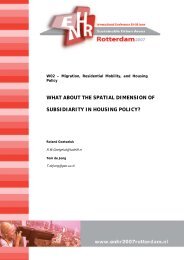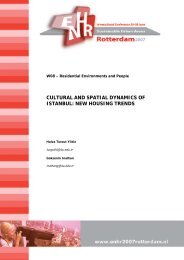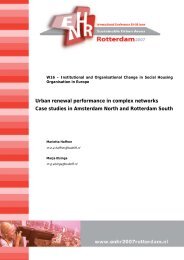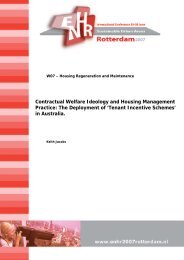Download abstracts - ENHR 2007 Rotterdam
Download abstracts - ENHR 2007 Rotterdam
Download abstracts - ENHR 2007 Rotterdam
You also want an ePaper? Increase the reach of your titles
YUMPU automatically turns print PDFs into web optimized ePapers that Google loves.
more useful perspective, since it is the process of »sprawling« that leads to undesirable<br />
development effects, and it is in the process of »sprawling« that policy must intervene.<br />
The aim of URBS PANDENS project was to provide a more general discussion of the nature of<br />
urban sprawl and to consider:<br />
• the extent to which common European patterns and processes of sprawl can be found,<br />
distinct from those previously identified in the USA;<br />
• a small number of important »archetypical« perspectives on European sprawl: life-style<br />
driven, infrastructure-related, state-regulated.<br />
• whether new theories can be formulated to explain urban sprawl;<br />
• what innovations might be suggested regarding the management of urban sprawl.<br />
Behind suburbanisation: New housing construction in Prague Metropolitan Area 1997-<br />
2005<br />
Darina Posova // posova@natur.cuni.cz, Ludek Sykora<br />
Charles University in Prague, Praha 2, CZECH REPUBLIC<br />
Numerous recent articles about urban change in post-socialist cities present suburbanisation<br />
as the main process that reshapes the geography of metropolitan areas in Central and Eastern<br />
Europe. Our paper does not question these findings. However, on the example of Prague it<br />
brings an additional dimension that helps to clarify the significance of suburbanisation process<br />
in the context of overall urban change. We focus on residential suburbanisation and use data<br />
about new housing construction in 1997-2005, i.e. since the beginning of more massive<br />
suburbanisation. Our findings show that despite suburban areas account for large share of<br />
newly constructed housing, majority is build within compact city. In suburban areas, new<br />
housing construction brings radical change of places where it concentrates. On the other hand<br />
side, even larger amount of new dwellings constructed in already established inner city<br />
neighbourhoods does not bring such a relative growth like in suburban belt. However, large<br />
share of new housing construction in central cities shows their vitality and strength of<br />
alternatives to suburbanisation. In addition the paper illustrates the strengthening position of<br />
Prague metropolitan area within the country and changing profiles of new housing construction<br />
in relation to the distance from the city centre, including size and price of dwellings. The main<br />
message, however, which we want to deliver and empirically document is that suburbanisation<br />
is not the single major process that reshapes post-communist Prague. There are alternatives<br />
that have to be considered in interpreting urban change in Central and Eastern Europe,<br />
alternatives that show the vitality of urban cores and offer more sustainable alternatives to<br />
sprawling post-communist metropolis.<br />
Crossing continents, changing places: The neighbourhood consequences of new<br />
immigration<br />
David Robinson // d.robinson@shu.ac.uk<br />
Sheffield Hallam University, Sheffield, UNITED KINGDOM<br />
Much is being said about new immigration in the UK, but little is actually known about the daily<br />
realities of new immigration or the factors shaping these experiences. Much is also being made<br />
about the contribution of new immigration to the supposed crisis of cohesion in urban society,<br />
but little is known about the neighbourhood consequences of new immigration. Research and<br />
analysis of new immigration has tended to focus on broad policy concerns (such as the<br />
operation of the asylum system), wider impacts of new immigration (such as the consequences<br />
for the national economy) or the particular experiences of new immigrants (such as the<br />
incidence and experiences of homelessness). Analysis has largely failed to situate the<br />
experiences of new immigrants in the particular places that they reside and to consider if and<br />
how these experiences vary between different places, or to recognise and explore the<br />
transforming effect of new immigration at the local level. This paper proposes a conceptual



